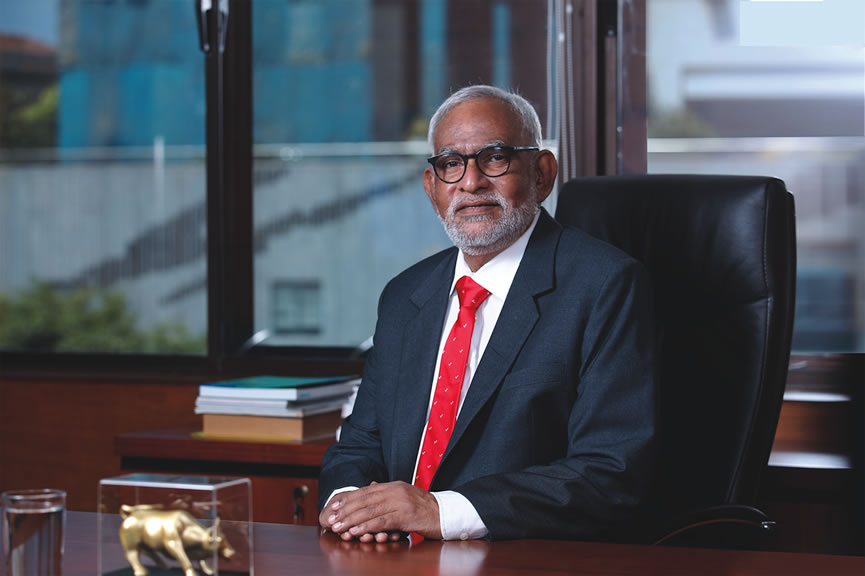
We simply cannot sit back and wait for the bad times to tide over. We have to learn to adjust and find innovative ways of moving forward with the resources at our disposal. Our task is to be uncompromising with the Bank’s mission and vision.
The year 2022 was one of maintaining a delicate balance in the Bank’s approach: taking advantage of emerging opportunities to drive value creation in the short – to mid-term while also providing support to those negatively impacted by the difficult circumstances in the country. These two aspects are not in conflict. It is only by securing our viability and financial soundness as a bank that we can play a vital role in delivering value to our stakeholders and aiding in the country’s economic growth. Striking this balance was the theme of our year, and it will shape how we proceed through the times ahead.
Having contended with numerous challenges during 2022, the factor that had the greatest impact on our performance was interest rates. Due to the prevailing high interest rate regime, the viability of businesses became hard to sustain. The capacities of businesses to service their debts were severely compromised, and we were faced with non-performing credit facilities on a wide scale with even previously reliable customers struggling to meet their deadlines. We restructured facilities of those who were in difficulties to bring monthly instalments within a reasonable range. But even with these concessionary terms, it was difficult for many businesses to meet their commitments as the interest alone took up a significant portion of their monthly instalments. In terms of our sources of funding, we were compelled to compete with the Government to mobilise deposits, with interest rates reaching 30%.
Along with interest rates, the other major issue that assailed the economy was the foreign exchange crisis. Thankfully, a measure of stability and normalcy has now been restored due to two reasons. Firstly, we have begun receiving a reasonable amount of foreign exchange inflows from remittances and exports. Secondly, the import of non-essentials has been curtailed, largely due to the high exchange rates. Though foreign exchange is not adequate to meet the country’s total requirements, we have been able to rationalise the allocation of resources. Rationalisation, however, means difficult choices, and problems persist. For example, the high exchange rate has put tremendous pressure on parents who are funding their children’s education overseas. The Bank’s response this year has had to take into account this complex and unpredictable scenario.
Empowering Women
Nevertheless, we have continued to maintain our focus on our priority areas – especially because it is this clarity of purpose that will drive the Bank forward. We are continuing our emphasis on women’s banking, and are extending our efforts to the periphery among our branches across the country. This is in alignment with the renewed focus on women all over the world, especially in developing countries, and the growing belief that women’s empowerment and education of female children are an important pathway to economic development and stability. We are looking at continuous savings based on dedicated propositions and strategic lending as tools for women’s empowerment. We encourage women entrepreneurship by providing access to loans, especially to start and establish small enterprises. Our approach is not concerned with scale at the outset. We feel that potential entrepreneurs can always start small and scale later as they gain confidence from access to the industry ecosystem and other players in the value chain. Our approach is to help create an ecosystem, with the right knowledge and know-how, so that more women will take up the challenge of heading their own businesses.
Focusing on SME Growth
The receipt of USD 150 Mn in funding from Development Finance Corporation, USA, makes DFCC Bank one of the last to receive such large funds into the country. A major portion of this funding has been disbursed for women’s banking and low-end SMEs. At present, the prospects of receiving further concessional funding from overseas is limited until there is proper debt restructuring and debt sustainability at national level, which, in turn, depends on the anticipated assistance from the IMF. This assistance is a prerequisite for us to regain access to international capital markets and to inject energy and momentum into the country’s economy.
Though digitalisation is regarded as the way forward for helping SMEs and bringing them into the fold, I am of the view that human relationships are equally important, especially in the local context. Smaller entrepreneurs will certainly benefit from being able to deposit, withdraw, and make payments through digital banking. However, this is just one piece of the puzzle. Our approach to financial inclusivity also focuses on direct personal contact with SMEs and providing industry-specific knowledge and opportunities for networking with members of the value chain. It is the combination of all these elements and points of assistance that allow SMEs to thrive and reach the next level.
Towards Greater Financial Inclusion
The informal financial sector has been a perennial issue in the industry. People generally fall victim to unethical operators, who charge extortionate interest rates, because of a lack of access and limited financial literacy. They lack proper documentation or support from anyone who can guide them on how to approach the formal sector, structure their loan request in an appropriate manner, calculate their profit potential, repayment capacity, etc. What is required is widespread financial literacy, which is the best tool available to win the battle against informal lenders. We were quite successful in weaning away people from such operators until the pandemic intervened, and we had to curtail our branch-wide efforts in educating people and imparting financial literacy. However, we recognise that financial literacy is an essential aspect of the broader project of financial inclusion, and is needed now more than ever. Our efforts in this area are in keeping with the original DNA of DFCC as a development bank.
Transformative Technologies
Our digitalisation strategy has reached a stage of transformative change as we have successfully implemented a completely new, state-of-the-art core banking system. We are making the system more streamlined and customised to meet our specific objectives so as to reap the benefits of total digitalisation. Our approach is to anticipate emerging trends and build capabilities for services that have not yet become widespread – for example, integrating customers’ businesses into our own systems, such as B2B systems and B2C systems. Our new core banking system not only provides us with the functionality we need today, but also with the structure to build towards the digital banking of tomorrow. Additionally, as we operate in a highly regulated industry, we have initiated the integration of established and proven emerging technologies in compliance with relevant regulatory frameworks.
We view digitalisation and sustainability as interrelated and mutually reinforcing. Our approach incorporates both aspects, including educating our employees on sustainable goals, implementing paperless initiatives and online training programmes.
Strategy for Sustainability
We have reached a point where our approach to sustainability is maturing into a proper actionable state. The past year was spent primarily on defining our sustainability strategy, defining our processes, defining responsibilities, and finalising our plans through enablers such as collaboration, digitalisation, empowerment, innovation and inclusion. Since we have completed that stage, we will be in a position to deliver sustainability on all fronts, including the contribution to a net zero environment in the future. Our connection to various funding institutions requires the evaluation of sustainable business practices when lending to organisations, and we are starting to record and measure the potential for sustainability in the loans we give. As 2023 unfolds, we are positioning ourselves to be able to access low-cost funds from institutions who are interested in driving sustainability in this country.
What the Future Holds
We are focused on organic growth for the Bank, as our inherent strengths, resilient nature, and overall structure favour such a route. Considering the overwhelming challenges we are likely to encounter during the coming year, we certainly expect a certain amount of prudence and caution, even conservatism, to be embedded within our processes. However, we simply cannot sit back and wait for the bad times to tide over. We have to learn to adjust and find innovative ways of moving forward with the resources at our disposal. Our task is to be uncompromising with the Bank’s mission and vision. While the context may create delays in achieving our long-term goals, most of them are now within the realm of possibility, and we draw confidence from our progress so far.
In terms of resources, we have a highly competent and diverse Board that supports the management in formulating the most suitable strategy after considering all available factors and options. We also have a dynamic new CEO, who is eminently capable of taking the Bank forward towards a great future.
Expressing My Gratitude
My sincere thanks to our staff members who worked diligently and tirelessly during the year; our Board members who gave the best of their experience and expertise; and the Governor and staff of the Central Bank of Sri Lanka for their oversight and guidance during such difficult times. Our customers continue to inspire us with their loyalty and confidence in us, for which a special word of thanks is due. I look forward with confidence as we possess the necessary skills and resources, and the best people and the right strategy, to overcome all obstacles and achieve all the goals we have in mind for the coming year and beyond.

J DURAIRATNAM
CHAIRMAN
17 February 2023
